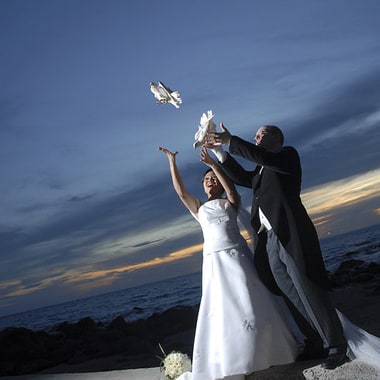
At traditional Filipino wedding receptions, the bride and groom release two doves into the air to represent a long, peaceful, and harmonious life together.

The Kissing Tradition: Sweden
If the groom leaves the room for any reason, all the other men at the wedding are allowed to kiss the bride. The same goes for the groom and female guests if the bride should leave the room.
If the groom leaves the room for any reason, all the other men at the wedding are allowed to kiss the bride. The same goes for the groom and female guests if the bride should leave the room.

In Peru, single female guests take part in a tradition a little sweeter than a bouquet toss. Charms attached to ribbons are tucked between the layers of the wedding cake. Before the cake is cut, each woman grabs a ribbon and pulls. At the end of one ribbon is a fake wedding ring. The guest who picks that ribbon is said to be next in line for marriage.

The breaking of the glass in Jewish weddings, in which the groom crushes a glass under his foot at the end of the ceremony, is a tradition with murky roots. Some hold that the breaking glass symbolizes the destruction of the great Temple in Jerusalem in A.D. 70, while others say that the broken glass is a reminder that joy should always be tempered. Either way, breaking the glass is usually undertaken in the spirit of happiness today, with wedding guests calling out "mazel tov!" (good luck!) after the glass shatters.

The sharing of the bread, salt and wine is an old Polish tradition. At the wedding reception, the parents of the bride and groom, greet the newly married couple with bread, which is lightly sprinkled with salt and a goblet of wine.
With the bread, the parents are hoping that their children will never hunger or be in need. With the salt, they are reminding the couple that their life may be difficult at times, and they must learn to cope with life's struggles. With the wine, they are hoping that the couple will never thirst and wish that they have a life of good health, and good cheer and share the company of many good friends.
With the bread, the parents are hoping that their children will never hunger or be in need. With the salt, they are reminding the couple that their life may be difficult at times, and they must learn to cope with life's struggles. With the wine, they are hoping that the couple will never thirst and wish that they have a life of good health, and good cheer and share the company of many good friends.

In Fiji when a man asks a woman's father for her hand in marriage, he must present his future father-in-law with a whale's tooth.

In Germany, newlyweds must instantly put their bond to the test by working together to saw a log in half in front of all their guests. The act is intended to showcase the bride and groom’s ability to work together and face the obstacles that may come throughout their marriage.

A traditional Chinese wedding features a full procession, with the bride escorted to the ceremony in a bridal sedan. Red is a powerful colour in Chinese weddings, symbolising boldness, luck, and love. According to tradition, the bride wears a red veil to hide her face, and her mother or attendant holds a red umbrella over the bride’s head to encourage fertility and grow her own family.

An Australian wedding ceremony might feature the tradition of a unity bowl. Guests are given stones and asked to hold them during the ceremony. At the end, guests place the stones in a decorative bowl that the couple will keep and display afterwards to remind them of the support and presence of their friends and family.

In Mexico, it’s common for a bride to carry a bouquet for herself, and a second as a tribute to the Virgin Mary.

As part of the elaborate and visually stunning traditional Indian wedding, brides and other female attendees are often dyed with intricate henna designs to represent the joy, hope, and love of the occasion.

Polterabend is a German wedding custom in which on the night before the wedding the guests break porcelain to bring luck to the couple's marriage. The belief in the effectiveness of this custom is expressed by the old adage: "Shards bring luck"

In Romania, a mock abduction game is common before wedding ceremonies take place. The bride is kidnapped by friends, family, or hired entertainers, and the groom must come to her rescue and pay her ransom through drinks, money, or romantic gestures.

In a traditional Indian wedding, the bride’s sisters play a trick on the groom by stealing his shoes once he enters the wedding tent. The groom must bribe the sisters to return his shoes before he exits.

At a Guatemalan wedding reception, the mother of the groom breaks a white bell to welcome the newlyweds to the party. The bell, filled with flour, rice, and grains, is meant to bring luck and prosperity.

In Kenya, the bride's father traditionally spits on the head and breasts of his daughter after the ceremony to bless her.

In this Scottish tradition, the bride, groom, or both are taken out on the day before their wedding, plied with alcohol, and covered in treacle, ash, feathers, and flour by friends and family. The celebratory mess was originally carried out to avoid evil spirits and bring good luck.

French weddings often serve a croquembouche, a truly delightfully tower of cream-filled pastry puffed that can be dipped in any number of sweet sauces, as the wedding cake.

Norway has its own particular version of the towering layered Western wedding cake, in the form of a kransekake, a tower of iced almond cake rings. It’s common to build the tower over a wine bottle so a nice treat appears as guests break off pieces of the dessert.

According to Korean tradition, grooms give their new mother-in-laws wild geese or ducks. The monogamous animals represent the groom’s pure intentions and loyalty to his bride. In a more modern reincarnation, brides and grooms exchange wooden geese and ducks on their wedding day as a sign of their commitment.
People who voted for this also voted for
Cat Vs Dog
But The Sign Says; More Personal Favorites
Winter (2014) in South Dakota (USA)
Anautix' Movie Diary 2016
Halloween "Re-Mixed"
Misc. Pictures That Struck My Fancy, part 2
Paleoart
"Steve Miller Band" Playlist
Christmas 3
Christmas 2
Animal World, Part 3, Them and the Kids
Fantasy, part 2
Babes & Bikes, part 17
Animal Candids 12, Odd Friendships
You Drive What??? (part 3) The Cars Of WalMart
More lists from Venice
Around the world with food and drink
Around the world with ... a potato.
Polish cities
Mars in movies
Around the world with ...a pancake.
Jean-Pierre Dardenne,Luc Dardenne - movies
Famous Caves in the World
 Login
Login





















